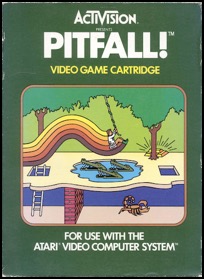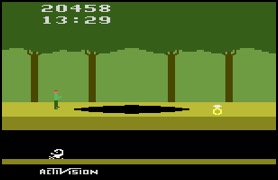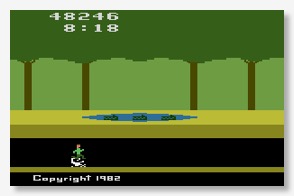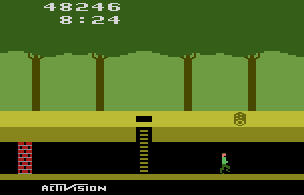21 - Pitfall Harry, the Jungle Runner
Become a Patron!

But these ideas were rare, and just beginning to find their way into video game lexicon, when David Crane came along and with one single game turned them into tropes. With just one game that had begun as a simple tech demo of a running man. One game that would go on to define a console generation, amid 64 consecutive weeks atop the Billboard bestsellers chart and a whopping four million lifetime sales on a gaming system that itself sold 30 million units.
That one game is Pitfall!, or Jungle Runner, as it was called during development, an Indiana Jones-like adventure distilled into the (home console) video game technology of the era.
This is the story of Pitfall!'s creation and its phenomenal legacy, pieced together from myriad sources — interviews, reviews, history articles, promo videos, book chapters, retrospectives, and a 2011 postmortem delivered at the Game Developers' Conference by none other than David Crane himself.
- Relevant links:
- David Crane's 2011 GDC Classic Game Postmortem on Pitfall!
- Pitfall Harry in Raiders of the Lost Shark is part of this Saturday Supercade episode
- Pitfall TV commercials (I only ended up using two of these):
- https://archive.org/details/Pitfall_1982_Activision
- https://archive.org/details/Pitfall_1982_Activision_US.mp4
- https://archive.org/details/Pitfall_-_Atari_2600_-_Australian_Commercial_1983
- https://archive.org/details/Pitfall_1982_Activision_US_a.mp4
- X-Play: Know Your Roots with David Crane
All music is my own work, except for the clips from Pitfall II and Jungle Hunt. Sound effects come from Atari 2600 versions of Pitfall I + II, Adventure, Superman, Dragster, Pong, Combat, Jungle Hunt, and Grand Prix, and from Utopia for the Intellivision. (Plus some stock tennis sound.)
Thanks as always to my supporters on Patreon — especially my $10+ backers Vivek Mohan, Simon Moss, Wade Tregaskis, Eric Zocher, and Seth Robinson. And a very big thank you (and warm welcome!) to my four new patrons this week. If you'd like to become a supporter, for as little as $1 a month, head to my Patreon page and sign up.
I've also just added a third way that you can donate to the show — a premium, ad-free feed on Breaker, where you'll get all the bonus audio that goes to Patreon (but none of the non-audio Patreon perks) for a monthly subscription of US$2.99. Head to https://www.breaker.audio/the-life-and-times-of-video-games-premium for more info.
(Partial) Transcript
It's strange to think of a time before jumping was a standard video game action, to be expected whenever and wherever you have control over an individual character. A time before you could hop onto enemies' heads and not die, or swing on ropes, or move back and forth across a vast level — many times wider than the screen.
But these ideas were rare, and just beginning to find their way into video game lexicon, when David Crane came along and with one single game turned them into tropes. With just one game that had begun as a simple tech demo of a running man. One game that would go on to define a console generation, amid 64 consecutive weeks atop the Billboard bestsellers chart and a whopping four million lifetime sales on a gaming system that itself sold 30 million units.

That one game is Pitfall!, or Jungle Runner, as it was called during development, an Indiana Jones-like adventure distilled into the video game technology of the era, and it was made by one guy, David Crane, in 1982.
[Pitfall TV ad]
This is the story of Pitfall!'s creation and its phenomenal legacy, pieced together from myriad sources — interviews, reviews, history articles, promo videos, book chapters, retrospectives, and a 2011 postmortem delivered at the Game Developers' Conference by none other than David Crane himself.
Speaking of David, let's quickly go over a little of his background. He had been making games of one sort or another all his life, but he didn't get a chance to turn his hobby into a profession until 1977, the year after Atari debuted its Video Computer System, or the 2600, as we know it today, and two years after he completed an electrical engineering degree. He had heard about a job opening at Atari during, of all things, a tennis match. His opponent happened to be Atari engineer Alan Miller, who asked David to look over a draft of the job ad they were about to file in the newspaper.
The next day David talked his way into the company, whereupon he coded home conversions of popular arcade games Outlaw, Canyon Bomber, and Slot Machine — as one of several nameless, uncredited programmers working for 20 or $30,000 a year to make titles that he soon learnt were earning the company tens of millions of dollars in cartridge sales.
In a moment that's since become part of video game industry folklore, David and his fellow star programmers then marched up to Atari president Ray Kassar to request fair compensation. The response, as retold by David Crane in his 2011 GDC talk, was rather less than accommodating:
"they said that we were no more important to the game than the person on the assembly line who put it together because without them we couldn't sell any games either.
So in 1979 a breakaway group of them, David Crane included, formed their own company, Activision, the first third-party console game publisher, and David launched himself into making original games about things. Because all console games at the time were about things. So he made games like Dragster, a drag racing game, and Laser Blast, a game where you pilot some flying saucers that are attacking the Earth.
But David quickly grew tired of creating games focused on objects — games about paddles and planes and tanks and boats and the like. He wanted to make a game centred around a character. A person. Or more specifically, a running man. Because nobody was making games for the Atari 2600 that starred animated characters.
He walked his six foot eight inch self — 207 centimetres in metric parlance — painstakingly back and forth around the Activision office, freezing in different poses to study his own leg and arm positions in the hopes that it would help him understand how those could translate into pixel positions for a running man no more than 16 wide and 22 high. Because that was about all the Atari 2600 could handle, with its 128 bytes of RAM — yes, bytes, not gigabytes or megabytes or even kilobytes, but bytes — and its 1.19 Megahertz processor and 160 pixels display.
Then he thought about how he might design a game for this running man to star in.
But on that point David came up empty. For two years he tried again and again to think up a game concept fit for his running man, but the closest he ever got was a cancelled cops and robbers game where a convict races through a city to escape the police. Then finally, in 1981, he sat down determined to design an adventure for the little dude to run through.
He picked up a blank sheet of paper and drew a stick figure standing between a couple of straight lines — in a sort of side view perspective cutaway. A man on a path. Which he then decided would be a jungle, because the first Indiana Jones film Raiders of the Lost Ark was screening at the time, and it was set in a jungle — so why not riff on that?

Then, to give his character some motivation for running, he drew in some treasures to collect and a bunch of snapping crocodile heads that the running man could swing over on a vine, like Tarzan, or hop onto with some precise timing, plus logs to avoid and an underground chamber that provided a secondary path to follow. To win, you'd have to find and collect all 32 treasures before your time runs out. And boom, after 10 minutes of brainstorming and more than two years of pondering, David had his running man game.
Well, sort of…I mean, he still had to actually build it, and that wouldn't be straightforward by any means — in fact, it'd take him about a thousand hours of programming to complete development. Because the important thing to understand about David is he didn't make games in the same way as most other programmers of the time — or now, for that matter — where they'd go through a process of devising variants and refinements to established game mechanics and interaction models and coding techniques. It wasn't that they were lazy and he wasn't, or anything like that; there was a solid practical reason for this approach, as David explained in that GDC postmortem:
"If you set out to design a game for this hardware, you almost had to think in hardware rather than software; you had to be thinking I need to send this value to that register to do this."
Which is a very abstract and unintuitive way of working. But that's how the Atari 2600 worked — to get it to put stuff on the screen, or to make sound, or to accept player input, you had to send it different kinds of numeric values that had predefined functions, like this number gives this background colour.
And so it's because of this unintuitive, super-difficult process, as well as the system's weak capabilities and short development deadlines at Atari, that by this time (a few years into the 2600's life) most games relied upon the tried and true techniques — on reused code, and reused ideas, with a little something new and different added or improved each time to make it fresh. You could think of it as innovation through refinement. But David's engineering background drove him down the harder path of innovation through invention.
(For more you'll have to either just listen to the episode or sign up as a supporter on Patreon — everyone who pledges $3 or more a month gets access to full episode transcripts [amongst other things].)

The Life & Times of Video Games on the Web and social media
- Website: lifeandtimes.games
- Twitter: @LifeandTimesVG
- Instagram: @lifeandtimesvg
- YouTube: https://www.youtube.com/channel/UCov7SwnAUcAUHFV8XxQW8HA
You can make a donation to help cover running costs and allow me to rely less on freelance income via
- Patreon: https://patreon.com/lifeandtimesofvideogames
- or PayPal: https://paypal.me/mossrc
- or Breaker: https://www.breaker.audio/the-life-and-times-of-video-games-premium
My book, The Secret History of Mac Gaming, is available in bookstores in the UK and Australia, as well as online from the likes of Book Depository and Amazon. See the official website for more info.
Can't afford to give me money? Consider listening via the RadioPublic app for Android or iOS. It's free. And if you enable analytics then I get paid a couple of cents each time you listen to my show. Head to https://radiopublic.com/the-life-times-of-video-games-G1V9N1 for more info.


